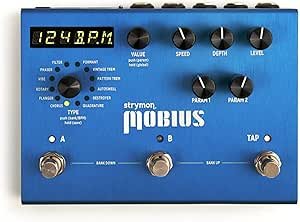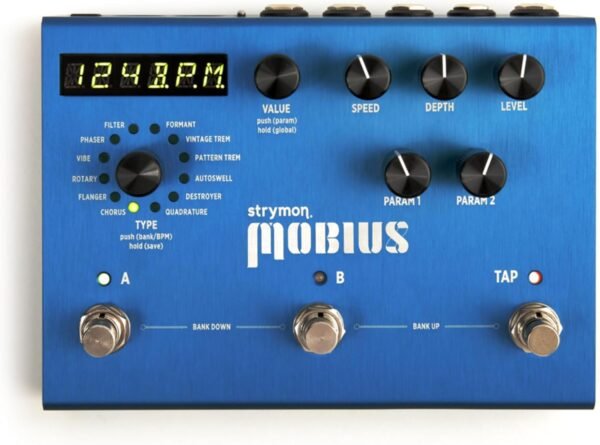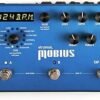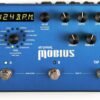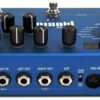Strymon Mobius Modulation Guitar Effects Pedal review exploring features and sound quality
Strymon Mobius Modulation Guitar Effects Pedal review exploring features and sound quality
- Incredible sound quality that delivers rich, detailed modulation effects without compromising tone.
- Extensive versatility with a wide range of effects, from vintage-inspired sounds to modern, experimental tones.
- The easy-to-navigate interface ensures seamless control over parameters, even during live performances.
- Durable construction feels solid and reliable, perfect for both studio and stage use.
- Exceptional tone shaping capabilities allow for deep customization, catering to diverse musical styles.
As an Amazon Associate I earn from qualifying purchases.
Description
A Versatile and Powerful Modulation Tool for Guitarists
The Strymon Mobius Modulation Guitar Effects Pedal is a highly talked-about piece of gear, and I had the pleasure of putting it through its paces. As someone who spends countless hours experimenting with pedals, I was curious to see if it lives up to the hype. Spoiler alert: It’s as impressive as people say, but it’s not without a few quirks that might matter to certain users.
Design and Build Quality
Right out of the box, the stunning blue finish caught my eye. It’s not just pretty; this pedal feels robust. Weighing in at 1.98 pounds, it’s light enough to fit into a pedalboard setup but still feels solid and reliable. The dimensions (9.9 x 5.6 x 3.7 inches) make it compact yet substantial, and the knobs and switches feel smooth and sturdy. One thing I appreciated was the clear and intuitive layout, which made it easy to navigate through its numerous features.
However, the absence of a battery power option might be a limitation for some. You’ll need the DC power supply to get this running, which isn’t a dealbreaker for me but might be for those who like the flexibility of battery-powered units.
Highlights
- 12 distinct modulation types including chorus, flanger, rotary, and tremolo. Each effect feels meticulously crafted, delivering tones that range from subtle to extreme.
- Digital signal processing that captures the warmth of analog while offering the precision of modern tech.
- Stereo input and output options, making it ideal for creating lush, wide soundscapes.
- The 240V compatibility ensures it can be used internationally, which is fantastic if you’re someone who gigs in different countries.
Performance and Sound Quality
The sound quality is where this pedal truly shines. Every effect is rich, detailed, and musical. I spent hours dialing in the chorus setting, and it transformed my clean tone into something shimmering and alive. The flanger didn’t disappoint either, delivering creamy sweeps without sounding harsh or artificial.
One standout feature is the preset functionality, allowing you to save and recall your favorite settings easily. This was super convenient during jam sessions, where I wanted to switch between different modulation types without fiddling around mid-song.
That said, the learning curve is real. With so many parameters to tweak, getting the most out of this pedal requires patience. It’s not something you just plug in and play—it demands experimentation.
Perks
- Modulation effects are top-notch and versatile.
- Durable build that can withstand heavy use.
- Easy preset saving for quick access during performances.
Areas for Improvement
While the Mobius is undoubtedly powerful, it’s not perfect.
- The price point might be steep for those just venturing into the world of modulation pedals.
- The lack of an expression pedal input feels like a missed opportunity for added flexibility.
- Some users might find the menu navigation system to be a bit cumbersome, especially if you’re used to simpler pedals.
Product Contenders
When comparing the Strymon Mobius to competitors, a few similar options come to mind. The Boss MD-500 Modulation Processor offers a comparable range of effects but feels less refined in terms of sound quality. What the Mobius does better is providing a warmer, more organic tone, whereas the Boss leans slightly toward the digital side.
Another rival, the Eventide H9, delivers exceptional sound and versatility. However, the H9 is heavily reliant on its app for full control, which might not appeal to everyone. The Mobius, on the other hand, provides a more tactile, hands-on experience.
Where the Mobius excels over its competitors is in its depth of control, though it might feel overwhelming for beginners. If simplicity is what you’re after, the MXR Phase 90, while limited in features, might be a better fit.
Cost Efficiency
For the features and quality it offers, I’d say the Strymon Mobius leans more toward the premium side of the spectrum, but it does deliver exceptional value for serious musicians. Cheaper alternatives might suffice for casual players, but if you’re after studio-quality sound and unparalleled flexibility, this pedal is worth the investment.
It’s one of those pieces of gear that feels like a long-term investment. While it might sting a bit upfront, the sheer versatility ensures it’ll likely remain a staple in your setup for years to come. That said, it does cater more to seasoned guitarists or those with a deep interest in sound design.
Final Thoughts on the Strymon Mobius
From its robust construction to the stunningly versatile soundscapes it creates, this pedal exceeded my expectations. There’s a reason it has become a favorite among guitarists who demand the best. While it’s not the most beginner-friendly option out there, anyone willing to invest the time to explore its capabilities will be richly rewarded. Just be prepared to spend some time diving into its features because this pedal is anything but plug-and-play.
Additional information
| Item Weight | 1.98 pounds |
|---|---|
| Product Dimensions | 9.9 x 5.6 x 3.7 inches |
| Item model number | Mobius |
| Is Discontinued By Manufacturer | No |
| Color Name | Blue |
| Hardware Interface | 1/4-inch Audio |
| Signal Format | Digital |
| Power Source | DC Power Supply |
| Voltage | 240 Volts |
